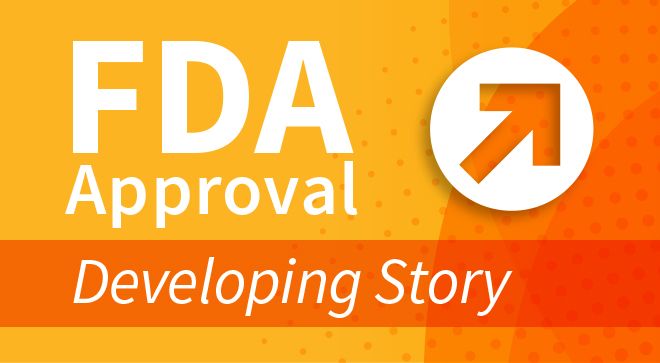Article
FDA Approves Yondelis in Soft Tissue Sarcoma
Author(s):
The approval is based on results from the phase 3 ET743-SAR-3007 trial.
The FDA has approved Yondelis (trabectedin) for the treatment of patients with unresectable or metastatic soft tissue sarcoma — specfically, liposarcoma and leiomyosarcoma — who have previously received chemotherapy that included an anthracycline.
The approval is based on results from the phase 3 ET743-SAR-3007 trial, in which Yondelis reduced the risk of disease progression by 45 percent versus dacarbazine in patients with advanced soft tissue sarcoma. There was also a slight survival trend with Yondelis, but the results were not significant.
“The treatment of advanced or metastatic soft tissue sarcoma represents a difficult challenge with few effective therapeutic choices available for patients,” said Richard Pazdur, director of the Office of Hematology and Oncology Products in the FDA’s Center for Drug Evaluation and Research. “Today’s approval of Yondelis provides a treatment option for advanced or metastatic liposarcoma and leiomyosarcoma.”
The open-label, multicenter, phase 3 SAR-3007 trial compared Yondelis with dacarbazine in 518 patients with liposarcoma and leiomyosarcoma who previously received an anthracycline-containing regimen followed by at least one additional line of chemotherapy. The protocol required patients to have an ECOG performance status of 0 or 1. The study was conducted at 85 sites in four different countries, but 94 percent of the patients were enrolled in the United States.
Patients were randomized in a two-to-one ratio to 1.5 mg/m2 of Yondelis (345 patients) or 1.0 g/m2 of dacarbazine (173 patients) once every three weeks until disease progression or unacceptable toxicity. Yondelis was administered through a catheter as an intravenous infusion over 24 hours and patients received dacarbazine as a 20- to 120-minute infusion. Patients in the Yondelis arm received 20 mg of intravenous dexamethasone as a premedication.
The median number of treatment cycles was two in the dacarbazine arm and four in the Yondelis group. In the Yondelis versus the dacarbazine arms, 34 percent versus 17 percent of patients, respectively, received at least six treatment cycles, with 11 percent versus 2 percent of patients receiving at least 12 cycles. The maximum numbers of cycles was 28 and 18 in the Yondelis and dacarbazine arms, respectively.
In the dacarbazine arm, 13.3 percent of patients (23 patients) had one prior line of chemotherapy, 43.4 percent (75 patients) had two prior lines, and 43.4 percent (75 patients) had three or more prior lines. Among patients receiving Yondelis, the rates were 11.0 percent (38 patients), 46.4 percent (160 patients), and 42.6 percent (147 patients), respectively. Additionally, the median time to randomization from the last disease progression was less than one month in both arms.
The primary outcome measure of the trial was overall survival. Secondary outcome measures included progression-free survival (PFS), objective response rate, time to progression, duration of response and safety.
After 329 PFS events, patients receiving trabectedin had a statistically significant reduction in the risk of disease progression, with a median PFS of 4.2 months versus 1.5 months with dacarbazine. The three-month PFS rates were 56 percent versus 34 percent for the two arms, respectively, and the six-month PFS rates were 37 percent versus 14 percent. The PFS benefit with trabectedin was observed across preplanned subgroups, including patients with leiomyosarcoma and liposarcoma.
Additionally, the PFS benefit was confirmed by an independent review of radiographic PFS.
ORR was 9.9 percent with trabectedin and 6.9 percent with dacarbazine. The clinical benefit rates (partial response, complete response, or stable disease at least 18 weeks) were 34.2 percent and 18.5 percent in the two arms, respectively. The median time to response and DOR were 3.07 and 6.47 months, respectively, with trabectedin and 2.35 and 4.17 months with dacarbazine.
The median OS was 13.7 months with trabectedin versus 13.1 months with dacarbazine.
Postprotocol anticancer treatments were received by 56.1 percent and 47.0 percent of patients, respectively, in the dacarbazine and Yondelis arms. Several of the treatments, including pazopanib, gemcitabine, docetaxel, and other drugs, as well as radiation and surgery were used more commonly in the dacarbazine arm.
There were no unexpected toxicities with either of the treatments. All-grade adverse-event (AE) rates were 99.1 percent and 98. percent percent in the Yondelis versus dacarbazine arms, respectively, with grade 3/4 AE rates of 76.2 percent versus 51.6 percent.
The most commonly reported all-grade AEs with Yondelis versus dacarbazine were nausea (73 percent vs 49 percent), fatigue (67 percent vs 51 percent), neutropenia (49 percent vs 29 percent), increased ALT levels (45 percent vs 6 percent), vomiting (44 percent vs 21 percent), anemia (39 percent vs 29 percent), constipation (36 percent vs 28 percent), increased AST levels (35 percent vs 5 percent), and diarrhea (34 percent vs 23 percent).
Grade 3 AEs with the highest frequency in the Yondelis arm were increased ALT levels (25 percent vs 1 percent), neutropenia (21 percent vs 11 percent), anemia (14 percent vs 11 percent) and increased AST levels (12 percent vs 0 percent). Sixteen percent of patients receiving Yondelis had grade 4 neutropenia compared with 10 percent in the dacarbazine group.
Treatment-related discontinuation rates were 7 percent and 10 percent in the dacarbazine and Yondelis arms, respectively. There were treatment-associated deaths within 30 days of the last dose among 3.2 percent of patients receiving Yondelis compared with none in the dacarbazine arm.
Yondelis carries a warning alerting health care providers of the risk of severe and fatal blood infections (neutropenic sepsis), muscle tissue breakdown (rhabdomyolysis), liver damage (hepatotoxicity), leakage around the vein or catheter (extravasation), tissue necrosis (breakdown) and heart failure (cardiomyopathy).





